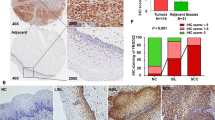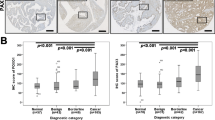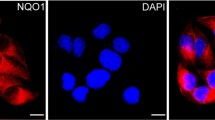Abstract
Purpose
Forkhead box protein O1 (FOXO1) and paired box gene 3 (PAX3) have been reported to play an imported role in human cancers, but their role in cervical cancer has not yet been clarified. In this study, we evaluated the functional role of FOXO1 in cervical cancer cells and investigated the expression and clinical significance of FOXO1 and PAX3 in cervical lesions.
Methods
In vitro assessment of cell function by cell viability, migration, and invasion assays were performed on FOXO1-knockdown cervical cancer cells. Immunohistochemical (IHC) staining analyses of FOXO1 and PAX3 were performed with a tissue microarray (TMA). The clinical significance was evaluated by comparing the data with various clinicopathologic characteristics, including survival of patients with cervical cancer.
Results
In vitro results revealed that knockdown of FOXO1 is associated with decreased cell viability (p < 0.001), migration (p < 0.001), and invasion (p < 0.05), supporting the oncogenic role of FOXO1 in cervical cancer. FOXO1 and PAX3 expression was significantly higher in CIN (both p < 0.001) and cancer tissue (both p < 0.001) than in normal tissue. Multivariate analysis indicated that FOXO1 expression (hazard ratio 4.01 [95% CI 1.22–13.10], p = 0.021) and an advanced FIGO stage (hazard ratio 3.89 [95% CI 1.35–11.19], p = 0.012) were independent prognostic factors for overall survival.
Conclusions
This study reveals increased FOXO1 and PAX3 expression in cervical cancers and indicates an oncogenic role of FOXO1 in cervical cancer cells that correlates with poor patient survival.




Similar content being viewed by others

References
Torre LA, Bray F, Siegel RL et al (2015) Global cancer statistics, 2012. CA Cancer J Clin 65:87–108
Duenas-Gonzalez A, Campbell S (2016) Global strategies for the treatment of early-stage and advanced cervical cancer. Curr Opin Obstet Gynecol 28:11–17
Small W Jr, Bacon MA, Bajaj A et al (2017) Cervical cancer: a global health crisis. Cancer 123:2404–2412
Lea JS, Lin KY (2012) Cervical cancer. Obstet Gynecol Clin N Am 39:233–253
Xing YQ, Li A, Yang Y et al (2018) The regulation of FOXO1 and its role in disease progression. Life Sci 193:124–131
Wang Y, Zhou Y, Graves DT (2014) FOXO transcription factors: their clinical significance and regulation. Biomed Res Int 2014:925350
Lu H, Huang H (2011) FOXO1: a potential target for human diseases. Curr Drug Targets 12:1235–1244
Fu Z, Tindall DJ (2008) FOXOs, cancer and regulation of apoptosis. Oncogene 27:2312–2319
Zhang B, Gui LS, Zhao XL et al (2015) FOXO1 is a tumor suppressor in cervical cancer. Genet Mol Res 14:6605–6616
Huang L, Huang Z, Fan Y et al (2017) FOXC1 promotes proliferation and epithelial-mesenchymal transition in cervical carcinoma through the PI3K-AKT signal pathway. Am J Transl Res 9:1297–1306
Boudjadi S, Chatterjee B, Sun W et al (2018) The expression and function of PAX3 in development and disease. Gene 666:145–157
Wang XD, Morgan SC, Loeken MR (2011) Pax3 stimulates p53 ubiquitination and degradation independent of transcription. PLoS ONE 6:e29379
Liu W, Sui F, Liu J et al (2016) PAX3 is a novel tumor suppressor by regulating the activities of major signaling pathways and transcription factor FOXO3a in thyroid cancer. Oncotarget 7:54744–54757
Eisenhauer EA, Therasse P, Bogaerts J et al (2009) New response evaluation criteria in solid tumours: revised RECIST guideline (version 1.1). Eur J Cancer 45:228–247
Livak KJ, Schmittgen TD (2001) Analysis of relative gene expression data using real-time quantitative PCR and the 2(−Delta Delta C(T)) method. Methods 25:402–408
Li R, Erdamar S, Dai H et al (2007) Forkhead protein FKHR and its phosphorylated form p-FKHR in human prostate cancer. Hum Pathol 38:1501–1507
Zhang Y, Jia L, Zhang Y et al (2017) Higher expression of FOXOs correlates to better prognosis of bladder cancer. Oncotarget 8:96313–96322
Coomans de Brachene A, Demoulin JB (2016) FOXO transcription factors in cancer development and therapy. Cell Mol Life Sci 73:1159–1172
Zhang Y, Gan B, Liu D et al (2011) FoxO family members in cancer. Cancer Biol Ther 12:253–259
Prasad SB, Yadav SS, Das M et al (2014) Down regulation of FOXO1 promotes cell proliferation in cervical cancer. J Cancer 5:655–662
Crosbie EJ, Einstein MH, Franceschi S et al (2013) Human papillomavirus and cervical cancer. Lancet 382:889–899
Staron MM, Gray SM, Marshall HD et al (2014) The transcription factor FoxO1 sustains expression of the inhibitory receptor PD-1 and survival of antiviral CD8(+) T cells during chronic infection. Immunity 41:802–814
Chen J, Xia L, Wu X et al (2012) Clinical significance and prognostic value of PAX3 expression in human glioma. J Mol Neurosci 47:52–58
Zhang L, Xia L, Zhao L et al (2015) Activation of PAX3-MET pathways due to miR-206 loss promotes gastric cancer metastasis. Carcinogenesis 36:390–399
Xu Y, Shao QS, Yao HB et al (2014) Overexpression of FOXC1 correlates with poor prognosis in gastric cancer patients. Histopathology 64:963–970
Wei LX, Zhou RS, Xu HF et al (2013) High expression of FOXC1 is associated with poor clinical outcome in non-small cell lung cancer patients. Tumour Biol 34:941–946
Tothova Z, Kollipara R, Huntly BJ et al (2007) FoxOs are critical mediators of hematopoietic stem cell resistance to physiologic oxidative stress. Cell 128:325–339
Dasari S, Wudayagiri R, Valluru L (2015) Cervical cancer: biomarkers for diagnosis and treatment. Clin Chim Acta 445:7–11
Park J, Ko YS, Yoon J et al (2014) The forkhead transcription factor FOXO1 mediates cisplatin resistance in gastric cancer cells by activating phosphoinositide 3-kinase/Akt pathway. Gastric Cancer 17:423–430
Han CY, Cho KB, Choi HS et al (2008) Role of FoxO1 activation in MDR1 expression in adriamycin-resistant breast cancer cells. Carcinogenesis 29:1837–1844
Goto T, Takano M, Hirata J et al (2008) The involvement of FOXO1 in cytotoxic stress and drug-resistance induced by paclitaxel in ovarian cancers. Br J Cancer 98:1068–1075
Grunkin M, Raundahl J, Foged NT (2011) Practical considerations of image analysis and quantification of signal transduction IHC staining. Methods Mol Biol 717:143–154
Tawfik OW, Kimler BF, Davis M et al (2006) Comparison of immunohistochemistry by automated cellular imaging system (ACIS) versus fluorescence in-situ hybridization in the evaluation of HER-2/neu expression in primary breast carcinoma. Histopathology 48:258–267
Author information
Authors and Affiliations
Corresponding author
Ethics declarations
Conflict of interest
The authors have no conflict of interest to declare.
Ethical approval
All procedures performed in studies involving human participants were in accordance with the ethical standards of the institutional and/or national research committee and with the 1964 Helsinki declaration and its later amendments or comparable ethical standards.
Informed consent
Informed consent was obtained from all individual participants included in the study.
Additional information
Publisher's Note
Springer Nature remains neutral with regard to jurisdictional claims in published maps and institutional affiliations.
About this article
Cite this article
Chay, D.B., Han, G.H., Nam, S. et al. Forkhead box protein O1 (FOXO1) and paired box gene 3 (PAX3) overexpression is associated with poor prognosis in patients with cervical cancer. Int J Clin Oncol 24, 1429–1439 (2019). https://doi.org/10.1007/s10147-019-01507-w
Received:
Accepted:
Published:
Issue Date:
DOI: https://doi.org/10.1007/s10147-019-01507-w



